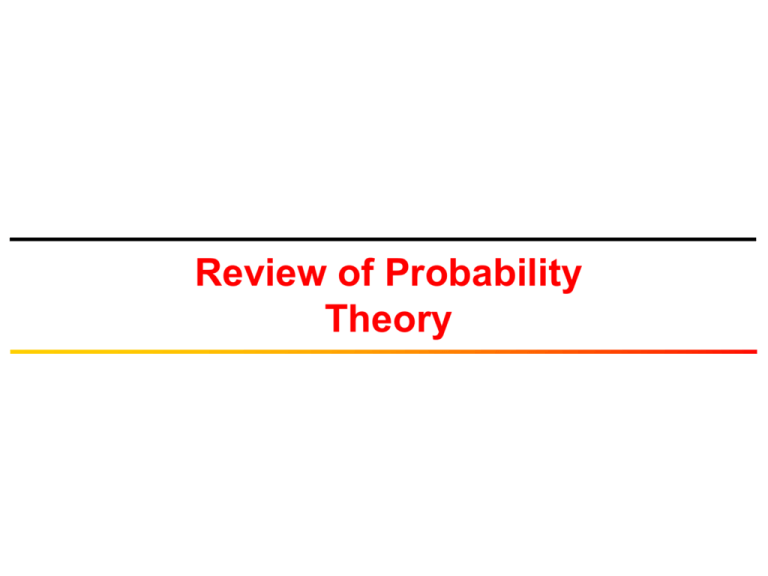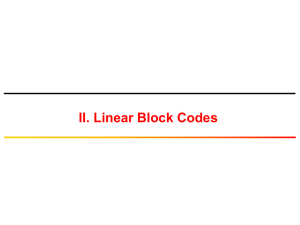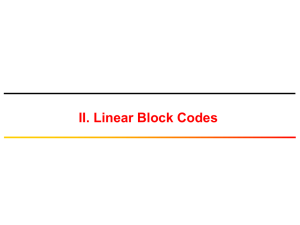Review of Probability Theory (1)
advertisement

Review of Probability
Theory
Review of Probability Theory
Experiments, Sample Spaces and Events
Axioms of Probability
Conditional Probability
Bayes’s Rule
Independence
Discrete & Continuous Random Variables
© Tallal Elshabrawy
2
Random Experiment
It is an experiment whose outcome cannot be predicted
with certainty
Examples:
Tossing a Coin
© Tallal Elshabrawy
Rolling a Die
3
Random Experiment in Communications
Transmission of Bits across a Communication Channel
v
Waveform
Generator
x
Channel
y
Waveform r
Detection
+A V.
vi
vi=1
vi=0
0
T
0
T
xi
-A V.
+
zi ]-∞, ∞[
yi
0
yi>0
yi<0
ri=1
ri
ri=0
Why is this a random experiment?
We do not know
© Tallal Elshabrawy
The amount of noise that will affect the transmitted bit
Whether the bit will be received in error or not
4
Random Experiment in Networks
Transferring a Packet across a Communication Network
Packet
Packet
Why is this a random experiment?
We do not know
© Tallal Elshabrawy
Whether the packet will reach the destination or not
If the packet reaches the destination, how long would it take to get
there?
5
Sample Space
The set of all possible outcomes
Tossing a coin
Heads
Tails
S = {H,T}
Rolling a die
S = {1,2,3,4,5,6}
The AWGN in a Communication Channel
S = ] -∞, ∞ [
xi
+
yi
zi
© Tallal Elshabrawy
6
Event
An event is a subset of the sample space S
Examples
Let A be the event of observing one head in a coin
flipped two times
A = {HT,TH}
Let B be the event of observing two heads in a coin
flipped twice
B = {HH}
© Tallal Elshabrawy
7
Axioms of Probability
Probability of an event is a measure of how often
an event might occur
no. of sample pts in A
P( A)
no. of sample pts in S
Axioms of Probability
1. 0 P A 1
2. P 0,P S 1
3. P A B P A +P B -P A, B
© Tallal Elshabrawy
8
Example
Let Event A characterize
that the outcome of rolling
the die once is smaller
than 3
A = {1,2}
P(A) = 2/6 = 1/3
Let Event B characterize
that the outcome of rolling
the die once is an even
number
B = {2,4,6}
P(B) = 3/6 = 1/2
© Tallal Elshabrawy
S
A
B
1
2
5
6
4
3
P A, B 1/ 6
P A B 1/3 1/ 2 1/ 6
9
Conditional Probability
Probability of event B given A has occurred
P A, B
P B A
P A
Probability of event A given B has occurred
P A, B
P A B
P B
© Tallal Elshabrawy
10
Example
Two cards are drawn in succession without
replacement from an ordinary (52 cards) deck.
Find the probability that both cards are aces
Let A be the event that the first card is an ace
Let B be the event that the second card is an
ace
P A, B =P A P B A
4 3
1
P A, B =
52 51 16 17
© Tallal Elshabrawy
11
Conditional Probability in Communications
+A V.
vi
vi=1
vi=0
0
T
0
T
xi
-A V.
yi
+
0
yi<0
Pr[error v=1]= Pr[r=0 v=1]
Pr[error v=1]= Pr[y<0 x=1]
Pr[error v=1]= Pr[x+z<0 x=1]
ri
ri=0
0.8
0.7
0.6
0.5
© Tallal Elshabrawy
yi>0
zi ]-∞, ∞[
Conditioned on v=1, what
is the probability of making
an error?
ri=1
0.4
0.3
r=0
Decision
Zone
0.2
0.1
0
-5
-4
-3
-2
-1
0
1
2
3
4
5
12
Bayes’s Rule
P A, B
P B A
P A
P A, B
P A B
P B
P(B A)P( A)
P( A B) =
P(B )
© Tallal Elshabrawy
13
Theorem of Total Probability
Let B1, B2, …, Bn be a set of mutually exclusive
and exhaustive events.
P( A) = ∑i =1 P A Bi P (Bi )
n
© Tallal Elshabrawy
( )
14
Bayes’s Theorem
Let B1, B2, …, Bn be a set of mutually exclusive
and exhaustive events.
(
)
P(B A) =
∑ P(A B )P(B )
P A Bi P(Bi )
i
n
i =1
© Tallal Elshabrawy
i
i
15
Independent Events
A and B are independent if
P(B|A) = P(B)
P(A|B) = P(A)
P(A,B) = P(A)P(B)
© Tallal Elshabrawy
16
Example
Let A be the event that the grades will be out on
Thursday P(A)
Let B be the even that I will get A+ in Random
Signals and Noise P(B)
So What is the probability that I get A+ if the
grades are out on Thursday P(B|A) = P(B)
© Tallal Elshabrawy
17
Random Variable
Characterizes the experiment in terms of real numbers
Example
X is the variable for the number of heads for a coin tossed three
times
X = 0,1,2,3
Discrete Random Variables
The random variable can only take a finite number of values
Continuous Random Variables
The random variable can take a continuum of values
© Tallal Elshabrawy
18
Bernoulli Discrete Random Variable
Represents experiments that have two possible outcomes.
These experiments are called Bernoulli Trials
Associates values {0, 1} with the two outcomes such that
P[X = 0] = 1-p
P[X = 1] = p
Examples
Coin tossing experiment maps a ‘Heads’ to X = 1 and a ‘Tails’ to
X = 0 (or vice versa) such that p=0.5 for a fair coin
Digital communication system where X = 1 represents a bit
received in error and X = 0 corresponds to a bit received correctly.
In such system p represents the channel bit error probability
© Tallal Elshabrawy
19
Binomial Discrete Random Variable
A random variable that represents the number of
occurrences of ‘1’ or ‘0’ in n Bernoulli trials
The corresponding random variable X may take and values
from {0, 1, 2, …, n}
The probability mass function PMF for having k ‘1’ in n
Bernoulli trials is
P[X = k] = nCk pk(1-p)n-k
Examples
In a digital communication system, the number of bits in error in a
packet depicts a Binomial discrete random variable
© Tallal Elshabrawy
20
Geometric Discrete Random Variable
Geometric distribution describes the number of Bernoulli
trials in succession are conducted until some particular
outcome is observed (lets say ‘1’)
The corresponding random variable X may take and values
from {1, 2, 3, …, ∞}
The probability mass function PMF for having k Bernoulli
trials in succession until an outcome of ‘1’ is observed
P[X = k] = (1-p)k-1p
Examples:
In a communication network, the number of transmissions until a
packet is received correctly follows a Geometric distribution
© Tallal Elshabrawy
21









